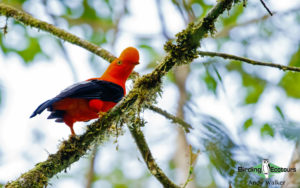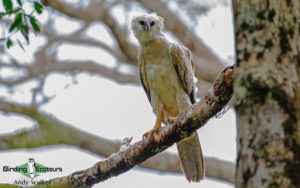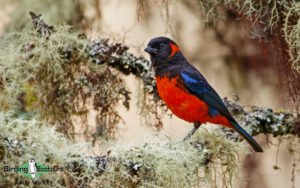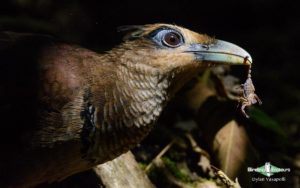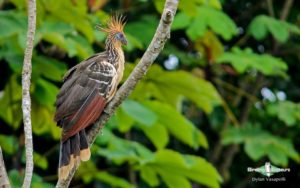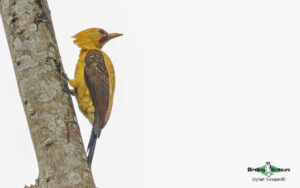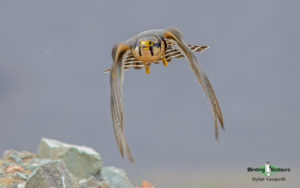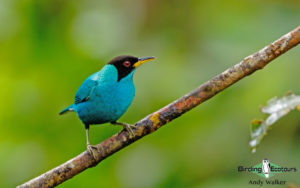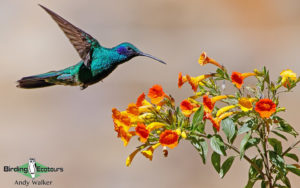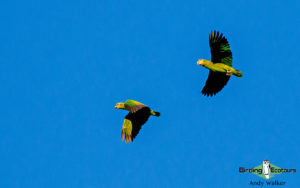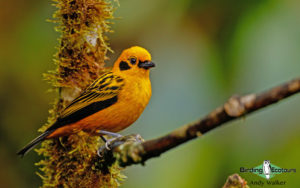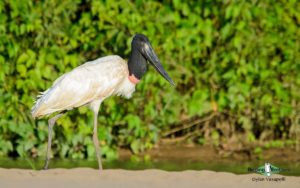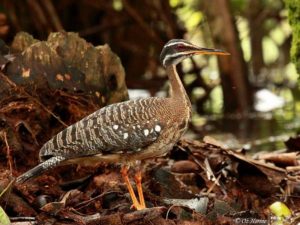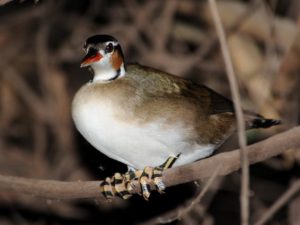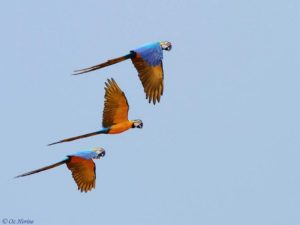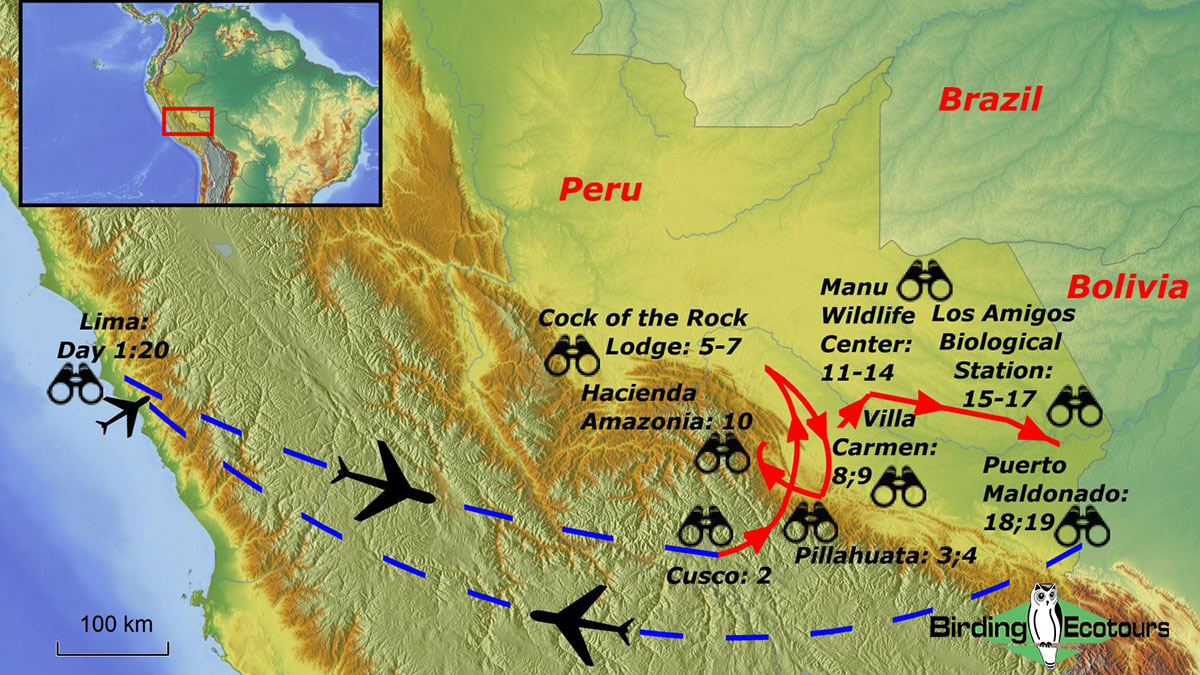Birding Tour Peru: The Manu Road and Lowlands
Birding Tour Peru: The Manu Road and Lowlands
September 2025
Our Birding Tour Peru: The Manu Road and Lowlands is perhaps the birding adventure of South America, and the Manu Road is one of the obligatory birding destinations of the world.
Our 20-day trip will take you to the city of Cusco, the ancient capital of the Incas, which will allow us to explore the mountains on the way to the world-famous Manu Road. This road connects the Andes of Cusco with the Amazon basin in the Madre de Dios region. It runs along the mountains to 4,000 meters/13,123 feet elevation and then descends to 500 meters/1,640 feet in the Amazon. Driving along this remote road will allow us to see different habitats and different altitudinal ranges, such as arid mountains and plateaus, paramo and elfin forest, humid cloudforest mountains, and then the Amazon basin of the Madre de Dios River, one of the most important Amazon River tributaries.
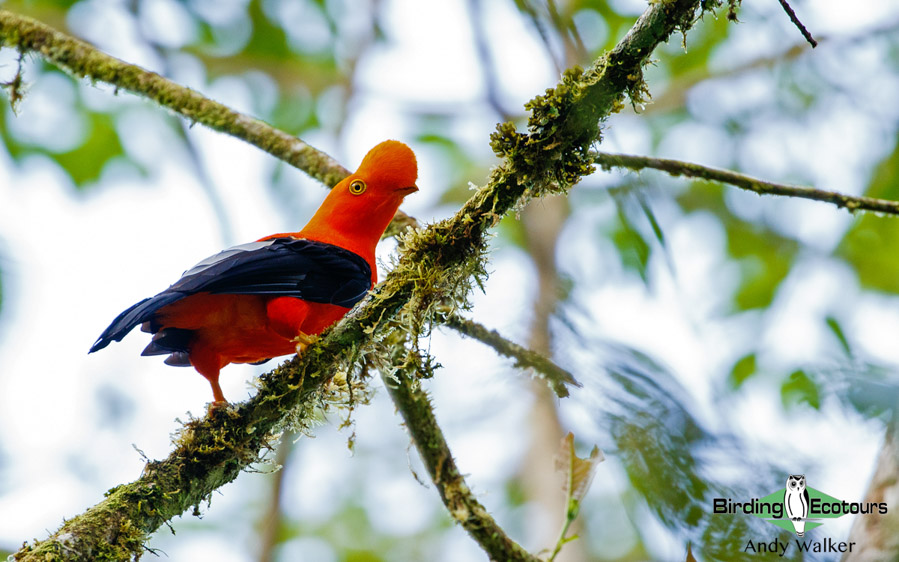 Andean Cock-of-the-rock is one of our targets on this trip.
Andean Cock-of-the-rock is one of our targets on this trip.
Each habitat exhibits a unique ecosystem and avifauna with some of the most representative birds of this part of the world, such as Andean Cock-of-the-rock, Andean Condor, Torrent Duck, Sungrebe, Sunbittern, Hoatzin, Red-billed Scythebill, Paradise Tanager, Pale-winged Trumpeter, Razor-billed Curassow, Undulated Tinamou, Lyre-tailed Nightjar, Blue-and-yellow Macaw, Band-tailed Manakin, White-throated Toucan, Grey-breasted Mountain Toucan, Pavonine Quetzal, White-capped Dipper, and a lot of hummingbirds, including the endemic Bearded Mountaineer, Giant Hummingbird, and the handsome Rufous-booted Racket-tail.
In addition to these most wanted and representative species the trip will provide a whole selection of range-restricted, country-endemic, and elusive species, such as Chestnut-breasted Mountain Finch, Creamy-crested Spinetail, Red-and-white Antpitta, Manu Antbird, Yungas Manakin, Rufous-headed Woodpecker, Peruvian Recurvebill, White-cheeked Tody-Flycatcher, Black-backed Tody-Flycatcher, Marcapata Spinetail, Rufous-fronted Antthrush, Amazonian Antpitta, Red-billed Pied Tanager, Rufous Twistwing, Purus and White-throated Jacamars, Orange-fronted Plushcrown, Fine-barred Piculet, Scarlet-hooded Barbet, and Blue-headed Macaw. We will be lucky if we have encounters with the rare Harpy Eagle and Rufous-vented Ground Cuckoo, both of which occur in the lowlands of the Manu National Park.
Rufous-vented Ground Cuckoo occurs in low densities in Manu National Park.
Three obligatory natural history shows are possible to witness on this trip, namely the display of the Andean Cock-of-the-rock, the macaws and parrots visiting the clay licks to ingest the minerals they need for their diet every day, and finally the mixed-flock activity, where several species of birds can travel in a single flock through the forest, including army-ant followers. The trip also offers good chances for wildlife, including species such as Emperor Tamarin and over seven species of monkeys, Giant Otter, and with luck Jaguar.
During this trip we will spend six days birding the mountains of Cusco and the upper parts of the Manu Road, visiting the Wayqecha Cloud Forest Biological Station and the Cock of the Rock Lodge, and 12 days visiting the main birding sites in the Amazon. First we will spend two nights at the recently-opened Villa Carmen Biological Station, which is a comfortable option for the lower Manu Road and the Atalaya area with independent rooms and private bathrooms, electricity, internet access, meal facilities, and a good selection of bird species including bamboo specialties – a great asset to our tours. Then we will visit the classic Hacienda Amazonia, where we will spend only one night, enjoying the beautiful grounds and hummingbird feeders, followed by four nights at the well-known Manu Wildlife Center, looking for several Amazonian specialists and visiting oxbow lakes and macaw clay licks, and then three nights at the lesser-known but comfortable Los Amigos Biological Station in our quest for a handful of localized, prized species and good chances of tracking down mammals. Finally we will spend two days in the Puerto Maldonado area, where we will look for open-country specialists.
Join us for this great adventure!
Itinerary (20 days/19 nights)
Day 1. Arrival in Lima
You will arrive at the Jorge Chávez International Airport near Lima and be transferred to your hotel.
Overnight: Hotel in Lima
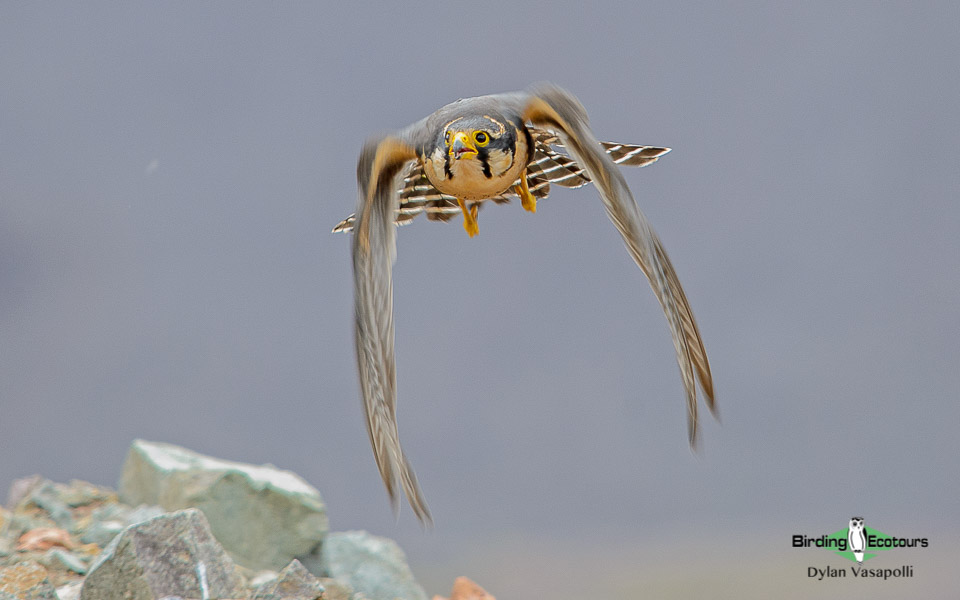 The attractive Aplomado Falcon
The attractive Aplomado Falcon
Day 2. Flight to Cusco, birding the Cusco area
We will have an early flight to the city of Cusco and start our birding day with exploring some wetlands and marshes near the city, where we should find species such as Puna Teal, Yellow-billed Pintail, Yellow-billed Teal, Andean Coot, Andean Lapwing, Plumbeous Rail, Cinnamon Teal, Andean Duck, Yellow-winged Blackbird, Andean Negrito, and other Andean wetland specialties. We will also encounter the first hummingbirds of the trip, including Giant Hummingbird, Sparkling Violetear, Green-tailed Trainbearer, and the endemic Bearded Mountaineer. We will have an easy afternoon in Cusco in order to rest well and acclimatize before starting our next day’s adventure.
Overnight: Casa Andina Hotel, Cusco
Day 3. Transfer to Pillahuata, birding on the way
Today we will leave Cusco to start exploring the famous Manu Road, one of the greatest bird-rich hotspots in South America. We will start looking for the endemic Chestnut-breasted Mountain Finch and the endemic Creamy-crested Spinetail. Other targets include Band-tailed Seedeater, Peruvian Sierra Finch, Andean Flicker, Aplomado Falcon, Black-chested Buzzard-Eagle, Black-throated Flowerpiercer, Spot-winged Pigeon, Brown-backed and Rufous-breasted Chat-Tyrants, Moustached Flowerpiercer, Grass Wren, Violet-throated Starfrontlet, Amethyst-throated Sunangel, Tyrian Metaltail, Andean Guan, Grass-green Tanager, Scarlet-bellied Mountain Tanager, Variable and White-throated Hawks, and many others. We will arrive in the Pillahuata area at 2800 meters/9186 feet elevation and stay at the Wayqecha Cloud Forest Biological Station for two nights.
Overnight: Wayqecha Cloud Forest Biological Station
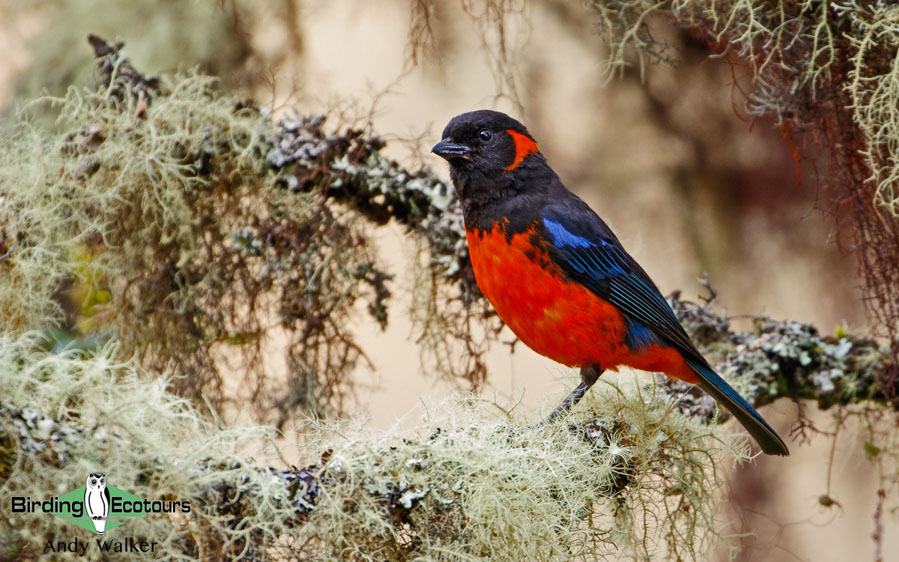 Scarlet-bellied Mountain Tanager can be seen along the Manu Road.
Scarlet-bellied Mountain Tanager can be seen along the Manu Road.
Day 4. Birding the Pillahuata area
After an early breakfast we will be ready to look for birds around Pillahuata for species like Grey-breasted Mountain Toucan, Masked Trogon, the endemic Marcapata Spinetail, Golden-collared Tanager, Hooded Mountain Tanager, the endemic Red-and-white Antpitta, Red-crested Cotinga, Masked Flowerpiercer, Trilling Tapaculo, Slaty-backed Chat-Tyrant, Streak-throated Bush Tyrant, White-banded, White-throated, White-tailed, and Black-capped Tyrannulets, Chestnut-bellied Mountain Tanager, Pearled Treerunner, Montane Woodcreeper, Rufous-capped Thornbill, Blue-backed Conebill, Collared Inca, Barred Fruiteater, and Black-throated Tody-Tyrant. If we are lucky we might find the nocturnal Swallow-tailed Nightjar after dinner.
Overnight: Wayqecha Cloud Forest Biological Station
Day 5. Birding the San Pedro area
We will leave Wayquecha and descend to the cloudforest in the San Pedro area. We will look for mixed flocks along the road including species like Citrine and Three-striped Warblers, Andean Motmot, Blue-banded Toucanet, Yungas Pygmy Owl, Andean and White-eared Solitaires, Great Thrush, Blue-and-black and Blue-capped Tanagers, Golden-headed Quetzal, Black-backed Grosbeak, White-collared Jay, Southern Mountain Cacique, Superciliaried and Drab Hemispinguses, Pale-legged Warbler, and if we are lucky Solitary Eagle and Black-and-chestnut Eagle.
Overnight: Cock of the Rock Lodge
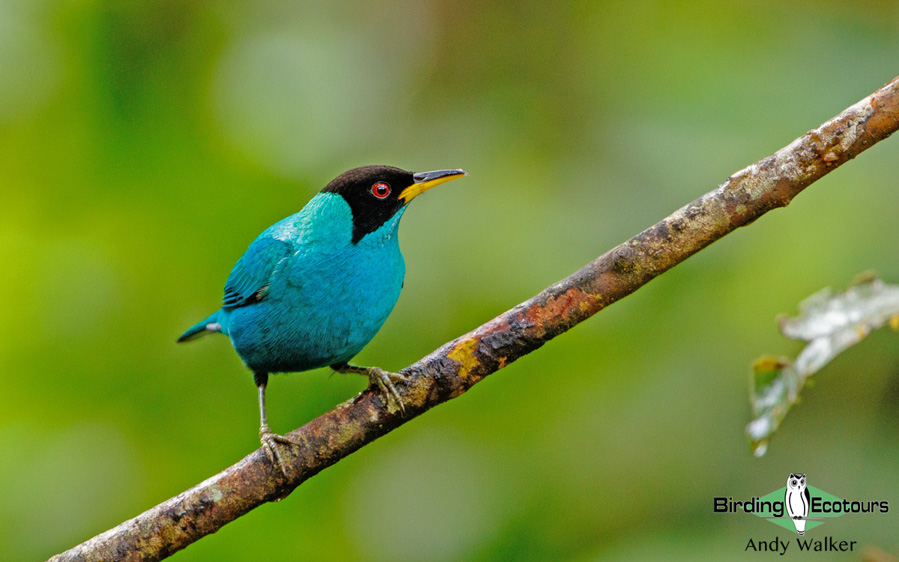 Green Honeycreepers can be seen at Cock of the Rock Lodge.
Green Honeycreepers can be seen at Cock of the Rock Lodge.
Days 6 – 7. Cock of the Rock Lodge
We will spend two full days around the Cock of the Rock Lodge, looking for a large selection of colorful species such as Paradise, Orange-eared, Golden, Spotted, Bay-headed, Blue-necked, Golden-eared, Slaty, Silver-beaked, Magpie, Saffron-crowned, and White-winged Tanagers, Blue Dacnis, Golden-collared and Green Honeycreepers, Versicolored Barbet, Black-faced Dacnis, Fiery-capped and Yungas Manakins, Black-eared Hemispingus, and others. In addition we should also find Scale-crested Pygmy Tyrant, Long-tailed Tyrant, Yellow-breasted Warbling Antbird, Chestnut-backed Antshrike, White-backed Fire-eye, Stripe-chested Antwren, Slaty Antwren, Ochre-faced Tody-Flycatcher, Scaly-headed Parrot, Chestnut-breasted, Mountain, and Moustached Wrens, Slaty Gnateater, and with luck Brown Tinamou around the lodge grounds.
The hummingbird feeders attract Violet-fronted Brilliant, Fork-tailed Woodnymph, Rufous-booted Racket-tail, Many-spotted Hummingbird, and Sparkling Violetear. The flowering bushes are good for Wire-crested Thorntail, Green Hermit, and Wedge-billed Hummingbird.
We will also try for Rufescent Screech Owl and Lyre-tailed Nightjar after dusk, and if we are lucky we might find Andean Potoo at its daytime roost.
Overnight: Cock of the Rock Lodge
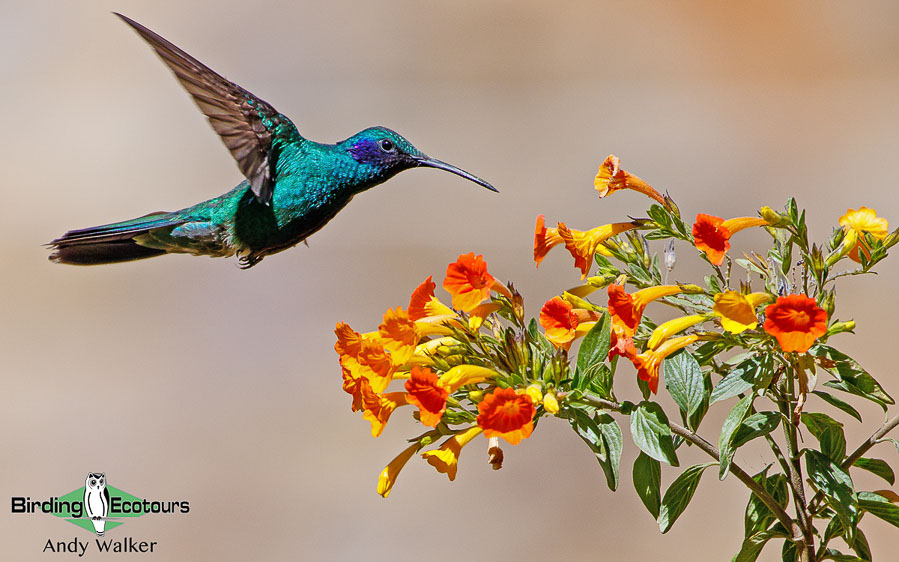 Sparkling Violetear often visits the feeders at Cock of the Rock Lodge.
Sparkling Violetear often visits the feeders at Cock of the Rock Lodge.
Day 8. Cock of the Rock Lodge to Villa Carmen Biological Station
Today we will enjoy the Andean Cock-of-the-rock display at the lek not far from the lodge, and after the show we will explore the area below the lodge, looking for the endemic Black-backed Tody-Flycatcher, White-lined Antbird, Red-billed Scythebill, Rusty-fronted Tody-Flycatcher, Bamboo Antshrike, Golden-crowned Flycatcher, Lemon-browed Flycatcher, Streaked Flycatcher, and Bluish-fronted Jacamar.
We will pass the villages of Patria and Pilcopata, where we have chances to see Chestnut-bellied Seed Finch, Chestnut-bellied Seedeater, Plumbeous Kite, Roadside Hawk, Yellow-bellied Dacnis, Cinnamon-faced Tyrannulet, Plain-crowned Spinetail, and others.
We will reach the Villa Carmen Biological Station, where we will spend two nights. After dusk we will try for Tropical Screech Owl and Tawny-bellied Screech Owl.
Overnight: Villa Carmen Biological Station
Day 9. Exploring the Villa Carmen area
We have a full day to explore the area around Villa Carmen, especially the bamboo trail, where we should find Manu Antbird, Bamboo Foliage-gleaner, Flammulated Bamboo Tyrant, Bamboo Antshrike, White-lined Antbird, Plain-winged Antshrike, Bluish-slate Antshrike, Ornate Stipplethroat, Pygmy Antwren, Blackish Antbird, White-flanked Antwren, Black-throated Antbird, White-browed Antbird, Rusty-belted Tapaculo, the endemic Fine-barred Piculet, Rufous-breasted Piculet, Orange-fronted Plushcrown, Chestnut-fronted Macaw, Blue-headed Parrot, Scarlet-hooded Barbet, Band-tailed Manakin, Yellow-crowned Tyrannulet, Masked Tityra, Pectoral Sparrow, Collared Trogon, Amazonian Motmot, and with luck Blue-headed Macaw.
Overnight: Villa Carmen Biological Station
Day 10. Hacienda Amazonia
Today we will transfer to the Hacienda Amazonia for an overnight. The place is very good for hummingbird species, including Koepcke’s Hermit and also Rufous-crested Coquette, Gould’s Jewelfront, Golden-tailed Sapphire, and Wire-crested Thorntail, all easily seen from the lodge balcony. Other birds include Grey-cowled Wood Rail, Speckled Spinetail, Southern Chestnut-tailed Antbird, Blackish Rail, Chestnut-capped Puffbird, Chestnut-eared and Lettered Aracaris, Black-tailed Trogon, Cinnamon-throated Woodcreeper, Black-banded Woodcreeper, Lineated, Little, Yellow-tufted, and Crimson-crested Woodpeckers, Fasciated and Rufescent Tiger Herons, Crested, Casqued, and Russet-backed Oropendolas, and Sand-colored Nighthawk. At night we will try for Great and Common Potoos.
Overnight: Hacienda Amazonia
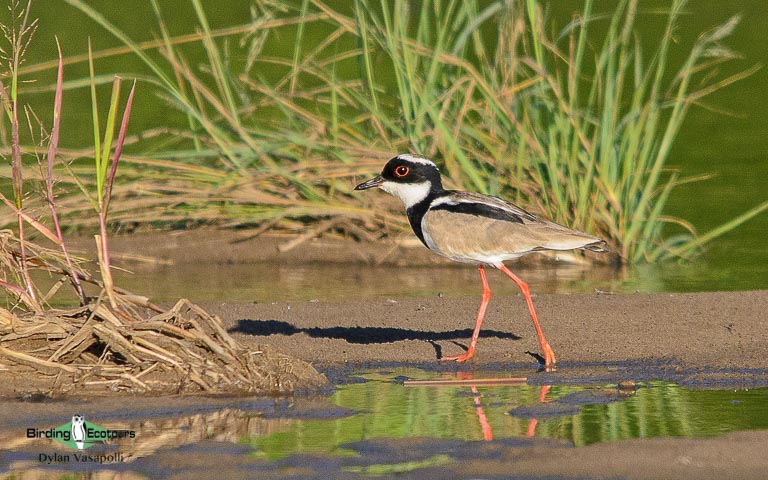 Pied Plover is regularly seen during our boat transfer.
Pied Plover is regularly seen during our boat transfer.
Day 11. Boat ride to the Manu Wildlife Center
After breakfast we will transfer by boat to the Manu Wildlife Center. The boat ride along the Madre de Dios River takes seven hours. During the boat trip we might see Black Skimmer, Pied Plover, Swallow-winged Puffbird, Great Black Hawk, Blue-throated Piping Guan, Red-and-green Macaw, Blue-and-yellow Macaw, and Scarlet Macaw.
Overnight: Manu Wildlife Center
Days 12 – 14. Manu Wildlife Center
We will spend three full days here, looking for Amazon lowland species like Razor-billed Curassow, Pale-winged Trumpeter, Musician Wren, Southern Nightingale-Wren, Red-necked Woodpecker, Festive Coquette, Reddish Hermit, White-chinned Sapphire, Great Jacamar, Pavonine Quetzal, Grey Antbird, Dusky-throated Antshrike, Common Scale-backed Antbird, King Vulture, Black-fronted and White-fronted Nunbirds, Western Striolated Puffbird, Rufous-headed Woodpecker, White-cheeked Tody-Flycatcher, and Dusky-tailed and Large-headed Flatbills.
The macaw clay lick will provide great views of all local macaw species, such as Scarlet, Blue-and-yellow, Red-and-green, Chestnut-fronted, and Red-bellied Macaws. Other parrots include Southern Mealy Amazon, Blue-headed Parrot, Orange-cheeked Parrot, Dusky-headed Parakeet, Rose-fronted Parakeet, and White-eyed Parakeet.
Overnight: Manu Wildlife Center
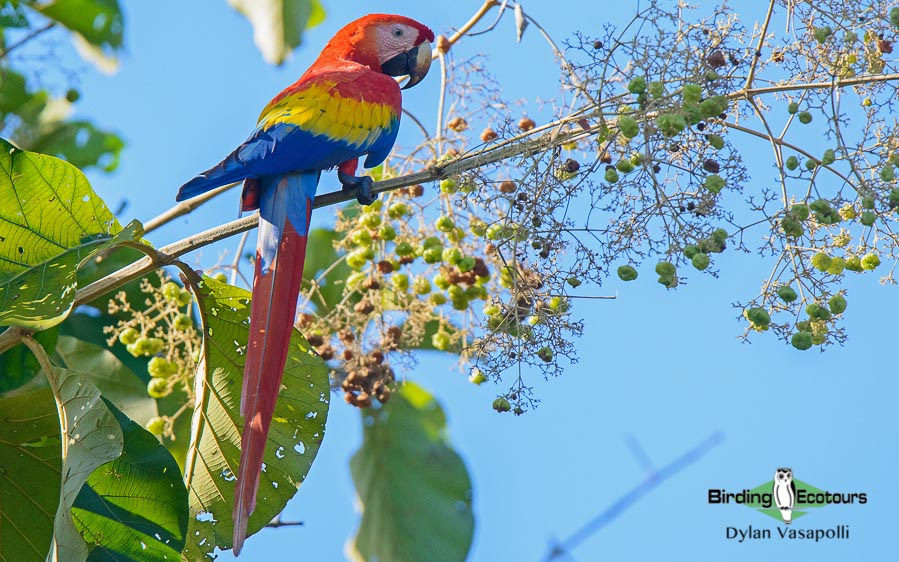 Scarlet Macaws visit clay licks near Manu Wildlife Center.
Scarlet Macaws visit clay licks near Manu Wildlife Center.
Days 15 – 17. Los Amigos Biological Station
Today we will leave the Manu Wildlife Center and travel along the Madre de Dios River for about two hours, looking for Orinoco Goose and also for Yellow-billed and Large-billed Terns and Pied Plover, and with a lot of luck we might find the elusive Jaguar resting along sandbars. We will continue our boat trip on the Los Amigos River, which is a tributary of the Madre de Dios River. Here we will look for the localized Red-billed Pied Tanager, Long-crested Pygmy Tyrant, Black-billed Seed Finch, Pale-eyed Blackbird, Rufous-fronted Antthrush, Black-faced Cotinga, and Varzea Schiffornis.
This location is particularly good for mammals, including more primates than other lodges with species like Emperor Tamarin and Black-faced Black Spider Monkey. Elusive mammals that can be seen at the Los Amigos River include Ocelot, Tayra, Nine-banded Armadillo, and with a lot of luck the seldom-seen Short-eared Dog.
Nocturnal hikes could provide sightings of Crested Owl, Spectacled Owl, Amazonian Pygmy Owl, and Tawny-bellied Screech Owl.
Overnight: Los Amigos Biological Station
Day 18. Transfer to Puerto Maldonado
We will have a long day to transfer by river and land to Puerto Maldonado. We will stay at the comfortable Cabaña Quinta Hotel.
Overnight: Cabaña Quinta Hotel, Puerto Maldonado
Day 19. Birding the Puerto Maldonado area
We have a full day to explore Puerto Maldonado and surroundings, looking for the localized Purus Jacamar and White-throated Jacamar and also for Black-faced Tanager, Red-breasted Blackbird, Grassland Sparrow, Lesser Yellow-headed Vulture, Rusty-backed Antwren, Barred Antshrike, Picui Ground Dove, and Southern Crested Caracara.
Overnight: Cabaña Quinta Hotel, Puerto Maldonado
Day 20. Departure
We will transfer to the Puerto Maldonado airport to connect with our flight to Lima, where we will say farewell and you will connect with your international flights.
Please note that the itinerary cannot be guaranteed as it is only a rough guide and can be changed (usually slightly) due to factors such as availability of accommodation, updated information on the state of accommodation, roads, or birding sites, the discretion of the guides and other factors. In addition, we sometimes have to use a different international guide from the one advertised due to tour scheduling.
Download ItineraryGENERAL INFORMATION ABOUT PERU CAN BE READ HERE.
‘We have travelled with Galo twice and had planned a third trip with him until world problems interfered. We have greatly enjoyed his company and good nature. He has been a tremendous guide with great ear for the bird calls and knowledge of all sites. He is very helpful and patient with us. He seems to anticipate our needs without our asking and adapts to our capabilities and interests. We look forward to travelling with him again.’
Jim and Barbara
